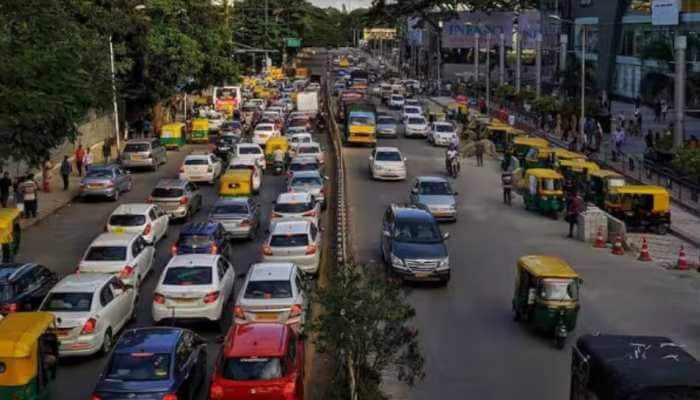China's plan to construct villages close to Indian border concerns security agencies
As per reports, Chinese Communist Party (CCP) cadres are stationed in these villages to counter “infiltration by hostile forces”. One of the key focus areas of this plan is developing connectivity infrastructure. The development of these border villages has serious implications for India’s defence. These 'Border Defence Villages' will change the demography of the border areas over time.
- The key focus areas of building “Border Defence Villages” is developing connectivity infrastructure.
- Chinese Communist Party (CCP) cadres are stationed in these villages to counter “infiltration by hostile forces”.
- The development of these border villages may have serious implications for India’s defence.
Trending Photos
)
Tibet was annexed by Chinese troops more than 60 years ago and China continues its brutal occupation of the region till this day. To create an “impenetrable security barrier” between occupied Tibet and the outside world, China has adopted a strategy of creating “Border Defence Villages”.
As per reports, Chinese Communist Party (CCP) cadres are stationed in these villages to counter “infiltration by hostile forces”. One of the key focus areas of this plan is developing connectivity infrastructure.
In 2019, the Chinese government constructed a major tunnel and bridge that would connect Tibet’s capital Lhasa to the Chinese province of Sichuan through a rail link. This new rail link is of great strategic importance to China and is located close to India.
The development of these border villages has serious implications for India’s defence. These 'Border Defence Villages' will change the demography of the border areas over time. The construction of these border villages is especially worrisome for India following the 2017 stand-off between India and Chinese troops on the Doklam Plateau. The plateau is only 9 kilometers away from Yadong county, Tibet. This region is considered strategically sensitive due to its location and its relative proximity from the Indian border.
“If China was to increase its influence over the region , it would allow Chinese forces to access the Siliguri Corridor, known as the “Chicken’s Neck”. If Chinese forces can exert influence over the “Chicken’s Neck” from Yadong, then China can cut off India’s access to the North East completely in times of war or disputes,” a source familiar of these developments told Zee News.
Chinese President Xi Jinping has stated that the frontiers of the nation must be governed well to be able to aptly administer to the whole country. Wu Yingjie, the CCP Chief of the Tibet Autonomous Region (TAR) has stated that Tibet is a special frontier ethnic region and therefore is extremely important to the national security of China and forms an ecological security barrier. The plan to create Border Defence Villages in Tibet, near the Indian border is outlined in the “Plan for the Construction of Well-Off Villages in the Border Areas of the Tibet Autonomous Region (2017-2020).”
The plan was issued back in 2017 and according to it, China would be creating more than 600 of these Border Defence Villages.
The CCP cadres are to be stationed in these villages, and their primary goal is repelling any attempted infiltrations by ‘hostile forces’ such as the Tibetans loyal to His Holinesses Dalai Lama. By placing faithful cadres at these villages, the CCP hopes that villages will follow or align with Chinese objectives.
These border villages are constructed on the routes that were in the past used by Tibetan’s to escape the CCP’s oppressive regime into Nepal and then into India. Another important role for the residents of these villages is to keep tabs on the movement of population and activities on the other side of the border. Most of the Border Defence Villages are being constructed in key areas such as Nyingtri/ Niyngchi. The region borders the Indian state of Arunachal Pradesh.
The Border Defence Villages also serve as a center for CCP’s ideological campaigns. The villages conduct intensive political education sessions in border areas. These political education sessions include the training of monks in Nyingtri.
Through this method, the monks are taught to go against the Dalai Lama’s influence. Penpa Lhamo, deputy head of the Contemporary Studies Institute of Tibet Academy of Science has stated that Nyingtri is vital to Chinese counter espionage operations because of the presence of many military sites in the region. As per Li Wei , an anti-terrorism expert with the China Institute of Contemporary International Relations, the temples in Tibet have always been the focus of the Chinese government’s plan as they are essential in maintaining the stability of Tibet.
The infrastructure that is closest to the actual border is known as “first-line” construction. As per Chinese state media, the majority of Border Defence Villages have been constructed on the ‘first line’ while around 200 Border Defence Villages have been constructed on slightly farther ‘second line’. Chinese state media has also revealed that Tibetans are often forcibly relocated and resettled in the border villages.
Zhu Hong, head of the organization department of the Gar County committee while taking about a new Border Defence Village called Demchog in the Gar County has stated that the goal is to turn these villages into “party building position and an indestructible battle fortess”.
He added that these villages would hold demonstration on the border as well as keep the motherland (Chinese mainland). In addition to passive security roles, these Border Defence Villages also act as outposts that try to identify “secessionist” elements. Chinese media has reported that the amenities available in these villages like- well constructed houses, paved roads, electricity, TV and internet meant to be seen as attractive to those on the other side of the border.
The construction and development of these Border Defence Villages have been praised by President Xi Jinping . In a letter to two sisters from a Tibetan herding family, Xi stated that he wished for the girls to “set down roots” in the new village, as well as safeguard Chinese territory . Xi also added that he wished for the Tibetan settlers to “develop their hometown”. The Chinese have invested vast sums of the developments of these Border Defence Villages.
According to M. Taylor Fravel , the Director of the Security Studies Program at the Massachusetts Institute of Technology , the local budget for the construction of these border defence villages is approximately 30 billion Yuan or $4.6 billion. Zhuangyan, Deputy Party Secretary, TAR Executive Chairman and the Chief Commander of the Construction Work Headquarters of Xiaokang Villages in March 2018 stated that the primary goal of the construction of these villages is to ensure consolidation of the border areas and to guarantee border security. In these senses, these border villages are similar to Xinjiang Production and Construction Corps farms. They offer the same benefits to China of increasing border control as well as consolidation.
Beijing and the CCP have long believed that it was much easier to control an unruly population when they are settled in and placed in well connected villages. Through the use of modern technology like surveillance cameras and mobile phones, the action of ‘resettled’ villages can be effectively monitored and controlled. The Chinese government finds it much easier to control these settled Tibetans than keeping track of them while they pursue their nomadic lifestyle.
Construction of these ‘Border Defence Villages ‘is intended for Chinese encroachment of lands of sovereign nations in its neighboring countries. These unilateral actions of the expansionist Chinese President Xi Jinping are in clear violation of the international norms. China has perhaps chosen this time of global health adversary as an ‘opportunity ‘ to push forward its expansionist ideology by accelerating works on setting up ‘Border Defence Villages ‘ seemingly assuming that it would go unnoticed.
Stay informed on all the latest news, real-time breaking news updates, and follow all the important headlines in india news and world News on Zee News.
Live Tv







)
)
)
)
)
)
)
)
)
)
